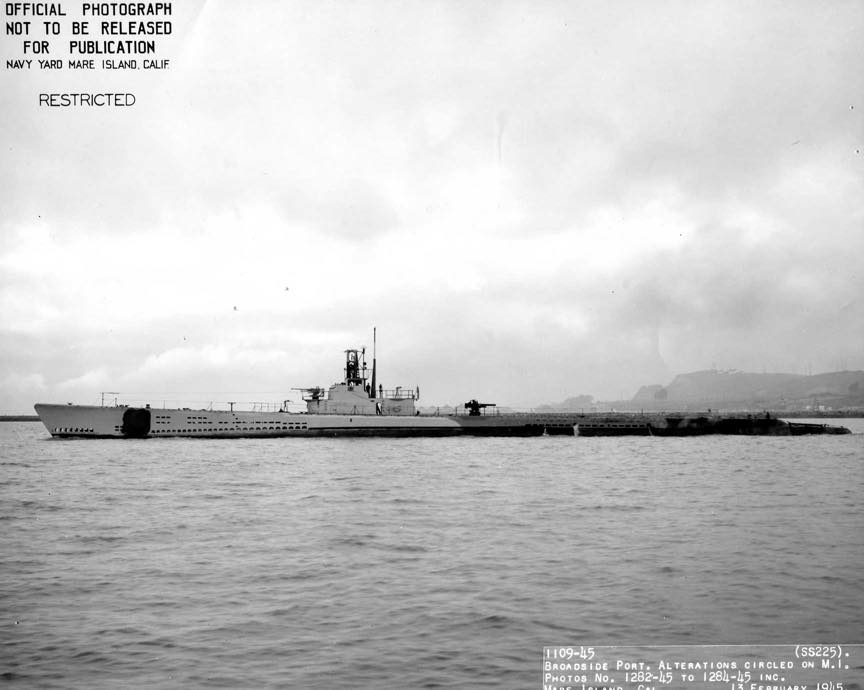Cero SS-225

A large food and game fish of the mackerel family, found chiefly in the West Indies.
The first Cero (No. 1189), a motorboat, served in the 2d Naval District in a noncommissioned status during 1917-18.
II
(SS-225; dp. 1,526: 1. 311'9", b. 27'3", dr. 15'3", s. 20
k.; cpl 60; a. l 3", 10 21" tt.; cl. Gato)
The second Cero (SS-226) was launched 4 April 1943 by Electric Boat Co., Groton, Conn.; sponsored by Mrs. D. E. Barbey, and commissioned 4 July 1943, Commander D. C. White in command.
Cero cleared New London 17 August 1943 for Pacific action waters, and on 26 September sailed from Pearl Harbor on her first war patrol, which was conducted in the East China and Yellow Seas. At dawn on 12 October, she made her first attack on a convoy of three freighters escorted by two destroyers. After heavily damaging one of the merchantmen, Cero plunged deep to endure the depth charging which followed. During the same patrol, she damaged two other freighters, and a small patrol boat which she engaged on the surface.
After refitting at Midway from 16 November to 13 December 1943, Cero made her second war patrol, an unproductive one, along the Truk-New Ireland route then put in to Milne Bay, New Guinea, from 12 January to 4 February 1944. Returning to the Truk-New Ireland shipping lanes, she attacked a freighter (later sunk by one of her sister submarines) and inflicted damage on another merchantman. She put in to Brisbane, Australia, 2 March, and sailed on her fourth war patrol, to be conducted off the Palau Islands, 3 April. Her most successful day to date came on 23 May, when she attacked two freighters and a tanker, sinking one cargo ship, and damaging the tanker.
Cero was refitted at Seeadler Harbor, Manus, from 2 to 26 June 1944, then put to sea for the dangerous waters off Mindanao, where on 5 August, she sent a Japanese tanker to the bottom. Fifteen days later she arrived at Brisbane, and on 19 September cleared Darwin, Australia, for the Mindanao and Sulu Seas. She called en route at Mios Woendi, where she took on board 17 tons of supplies for Philippine guerrillas, along with 16 soldiers headed for behind-the-lines operations in Luzon. Although not permitted by her orders to attack escorted merchantmen while on this mission, Cero encountered two small craft on 27 October' and in the resulting gun action, damaged both and forced them a ashore. On 3 November, north of Manila, she made contact with the guerrillas, landed the soldiers and supplies, and took four evacuees on board. Later taken under attack by a Japanese submarine Cero was able by alert bridge action to evade a torpedo aimed at her. Mission completed, she returned to Pearl Harbor 24 November, then sailed to the west coast for overhaul.
Cero shoved off for action from Pearl Harbor once more 31 March 1945, on her seventh and most productive war patrol. Cruising off Honshu and Hokkaido, she not only provided lifeguard services for air strikes on Japan, but sank two and damaged one Japanese picket boats, as well as sending three freighters and a large trawler to the bottom. Refitted at Guam and Saipan between 27 May and 27 June 1945, Cero had lifeguard and picket duty off EIonshu for her eighth war patrol. On 15 July, she rescued three survivors of a downed bomber, and later that day bombarded the Japanese lighthouse and radio station at Shiriya Saki, Honshu. On 18 July, while sailing for the Kurile Islands, Cero came under enemy air attack, and was damaged so severely by a bomb landing close aboard that she was forced to leave her patrol area for Pearl Harbor, arriving 30 July.
Cero made prolonged visits to New Orleans and Baton l Rouge before arriving ~ November 1945 at New London, where she was decommissioned and placed in reserve 8 June 1946. Here she was recommisioned 4 February I 1952, and on 22 March, Cero arrived at her home port ' at Key West. For the next year she cruised in the Caribbean and aided in the work of the Fleet Sonar School, then sailed north for inactivation. She was again decommissioned and placed in reserve at New London 23 December 1953.
Cero received seven battle stars for World War II, service. Of her eight patrols, all but the second were designated as successful war patrols. She is credited with having sunk a total of 18,159 tons of shipping.
